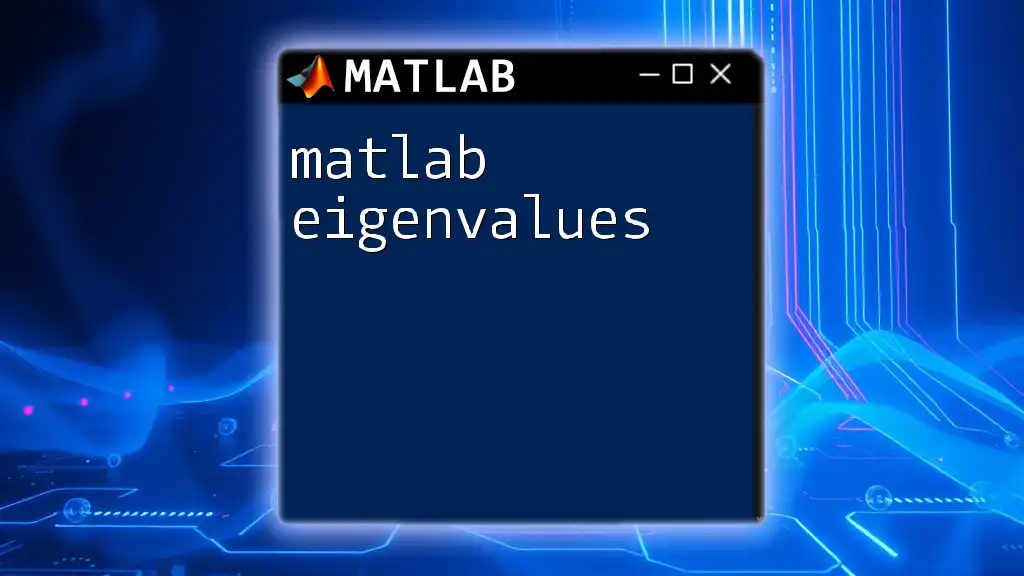In MATLAB, eigenvalues can be computed using the `eig` function, which returns the eigenvalues of a square matrix, revealing important properties of the matrix for various applications in engineering and science.
Here’s a simple example:
A = [4 2; 1 3]; % Define a square matrix
eigenvalues = eig(A); % Compute the eigenvalues
disp(eigenvalues); % Display the eigenvalues
Understanding Eigenvalues and Eigenvectors
The Mathematical Foundations
Eigenvalues are a key concept in linear algebra with significant implications for various fields such as engineering, physics, and machine learning. The fundamental relationship governing eigenvalues and eigenvectors is expressed by the equation \( Av = \lambda v \), where \( A \) is a square matrix, \( \lambda \) is an eigenvalue, and \( v \) is the corresponding eigenvector.
Eigenvalues reflect certain properties of a linear transformation represented by the matrix \( A \). When a matrix acts on an eigenvector, the output is simply a scaled version of the input, scaled by the eigenvalue. This scaling effect is a crucial insight into how systems behave — especially in dynamics and stability analyses.
Key Concepts
Characteristic Polynomial
To find eigenvalues, one typically starts by calculating the characteristic polynomial of a matrix \( A \). The characteristic polynomial is defined as the determinant of \( A - \lambda I \), where \( I \) is the identity matrix. By solving the polynomial equation:
\[ \text{det}(A - \lambda I) = 0 \]
one can find the eigenvalues as the roots of the polynomial.
Multiplicity of Eigenvalues
Eigenvalues can possess different types of multiplicity:
- Algebraic multiplicity refers to the number of times an eigenvalue appears as a root of the characteristic polynomial.
- Geometric multiplicity indicates the number of linearly independent eigenvectors associated with that eigenvalue.
Understanding these multiplicities is essential for analyzing systems, especially when determining their stability.

MATLAB Commands for Eigenvalue Computation
Basic Commands
In MATLAB, finding eigenvalues and eigenvectors is straightforward thanks to the `eig` function. This function returns both the eigenvalues and corresponding eigenvectors of a square matrix.
The syntax is as follows:
[V, D] = eig(A)
Where:
- \( V \) is a matrix whose columns are the eigenvectors of \( A \).
- \( D \) is a diagonal matrix containing the eigenvalues of \( A \).
For example, let's consider a simple matrix:
A = [4 2; 1 3];
[V, D] = eig(A);
disp('Eigenvalues:');
disp(diag(D)); % Displaying eigenvalues
This code snippet calculates the eigenvalues and eigenvectors for matrix \( A \) and displays the eigenvalues, which are stored in the diagonal of matrix \( D \).
Advanced Usage
For larger or sparse matrices, MATLAB provides the `eigs` function. This function is particularly useful as it computes a few eigenvalues and eigenvectors efficiently. The syntax is:
[V, D] = eigs(A, k)
Where \( k \) is the number of eigenvalues you wish to retrieve.
Here’s a quick example of how you can utilize `eigs`:
A = sparse(1000, 1000);
% Fill the sparse matrix here
% Example only showing how to call eigs
[V, D] = eigs(A, 6); % Computes 6 largest eigenvalues
Handling Complex Eigenvalues
Eigenvalues can sometimes be complex, especially in systems represented by certain matrices, such as rotation matrices. For instance, consider the following:
B = [0 -1; 1 0]; % Rotation matrix
[V, D] = eig(B);
disp('Eigenvalues:');
disp(diag(D)); % Should show complex eigenvalues
In this example, matrix \( B \) has complex eigenvalues, which are crucial for understanding oscillatory behavior in dynamical systems.

Practical Applications of Eigenvalue Analysis in MATLAB
Stability Analysis
In control theory and system dynamics, eigenvalues play a pivotal role in determining the stability of a system. If the real parts of all eigenvalues of a system's matrix are negative, the system is considered stable. Conversely, positive real parts indicate instability.
Principal Component Analysis (PCA)
Eigenvalues are essential for data analysis techniques such as Principal Component Analysis (PCA), which aim to reduce dimensionality while preserving variance. PCA involves computing the eigenvalues and eigenvectors of the data's covariance matrix.
Here’s how you might implement PCA in MATLAB:
data = rand(10, 3); % Example dataset
covarianceMatrix = cov(data);
[V, D] = eig(covarianceMatrix);
% Process eigenvalues to identify principal components
This code demonstrates how to compute the covariance matrix of a dataset and extract its eigenvalues and eigenvectors, which are key for identifying the directions (principal components) that maximize variance.

Visualization Techniques
Visualizing Eigenvalues and Eigenvectors
Visualizing eigenvalues and eigenvectors can provide insight into their geometric interpretations. MATLAB's powerful plotting functions can be employed for this purpose. A simple graphic representation of eigenvectors can be plotted using:
figure;
quiver(0, 0, V(1,:), V(2,:), 'r'); % Eigenvector visualization
axis equal;
title('Eigenvectors of Matrix A');
This snippet will draw arrows representing the eigenvectors originating from the origin, helping to visualize the transformations induced by the matrix.
Using Heatmaps to Represent Eigenvalues
Matlab allows for sophisticated visualizations such as heatmaps, which can represent the distributions of eigenvalues effectively. This form of visualization is especially useful when analyzing large datasets or systems with multiple eigenvalues.

Troubleshooting Common Issues
Debugging MATLAB Errors Related to Eigenvalues
When working with MATLAB eigenvalue computations, various issues can arise:
- Mismatched dimensions: Ensure that the matrix \( A \) is square since eigenvalue computations require a square matrix.
- Ill-conditioned matrices: These are matrices that may lead to inaccurate eigenvalue calculations due to their numerical properties. Regularization may be necessary.
Preventive Measures
To avoid common pitfalls, it is advisable to:
- Verify the matrix format before performing eigenvalue computations.
- Precondition matrices when necessary to improve numerical stability.

Conclusion
In conclusion, understanding the concept of eigenvalues and how to compute them using MATLAB is vital for various applications across mathematics, engineering, and data analysis. The `eig` and `eigs` functions in MATLAB provide users with the tools to effectively analyze and interpret eigenvalues, paving the way for deeper insights in system dynamics, machine learning, and beyond. Exploring these concepts further will undoubtedly enrich your understanding and capabilities in using MATLAB to its fullest potential.

















